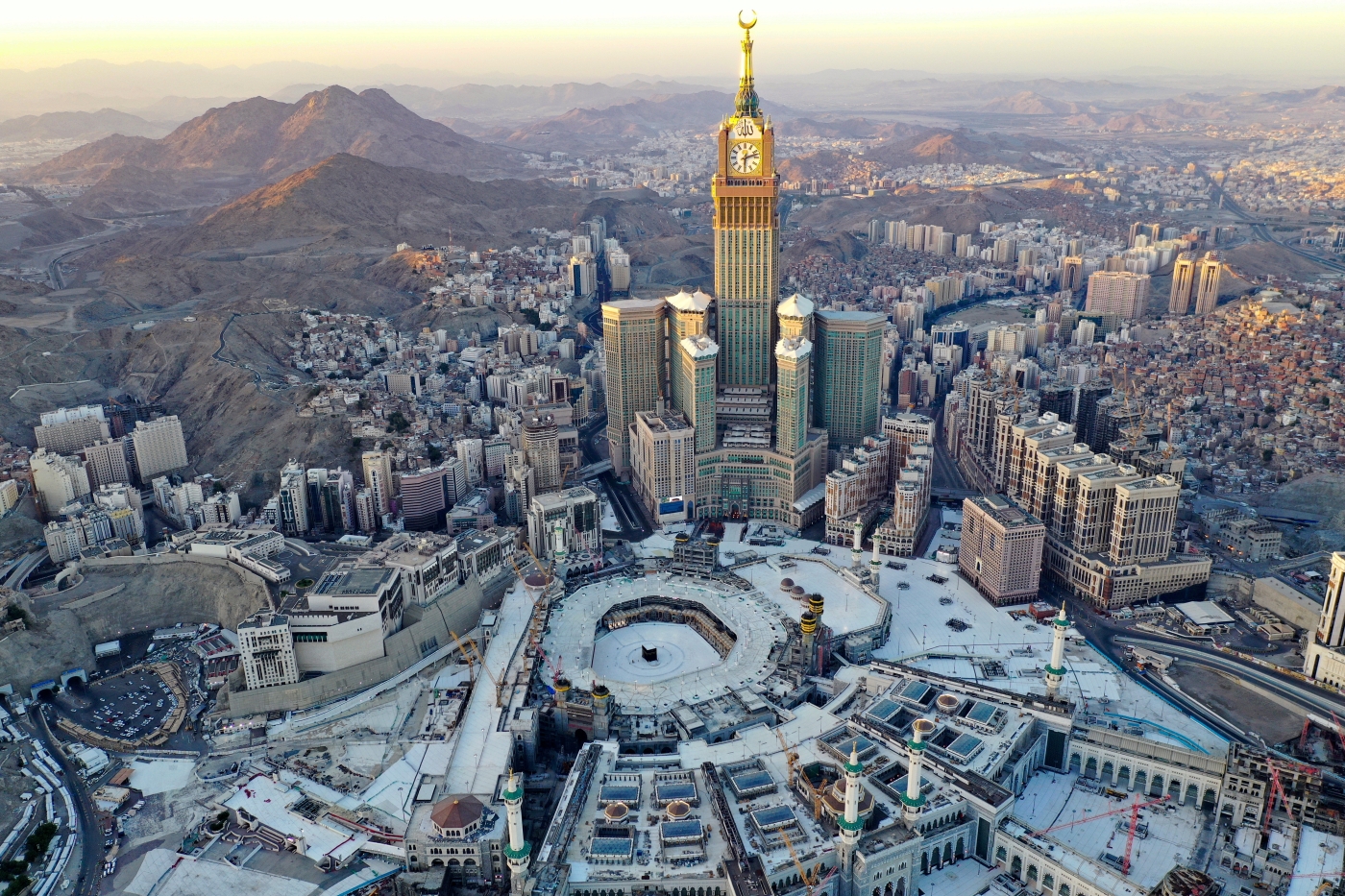
Saudi Arabia is home to a rich tapestry of historical sites that offer visitors a glimpse into its ancient past and cultural heritage. Here are ten of the country’s top historical sites:
1. Mada’in Saleh:
2. Al-Ula Old Town:
3. Diriyah:
4. Al-Balad:
5. At-Turaif District in Ad-Diriyah:
6. Al-Masmak Fortress:
7. Qasr Al-Hukm:
8. Al-Khazneh:
9. Al-Qarah Mountain:
10. Old Town of Al-Dir’iyyah:
1. Mada’in Saleh in Saudi Arabia:

Mada’in Saleh, also known as Al-Hijr, is one of the remarkable archaeological and historical sites located in the Al-Ula region of northwestern Saudi Arabia.
Designated a UNESCO World Heritage Site in 2008, Mada’in Saleh is often referred to as the “other Petra” because of its striking similarities to the famous Nabatean city in Jordan.
Once a thriving hub of commerce, this ancient site played a key role along the Incense Route—a vital trade network that connected the Arabian Peninsula to the Mediterranean world.
Today, it stands as a powerful testament to the region’s rich history and cultural depth.
Mada’in Saleh is perhaps best known for its breathtaking tombs from the 1st century CE, many of which are carved directly into the sandstone cliffs.
These monumental structures—called qasr in Arabic—are adorned with detailed facades crafted by Nabatean artisans, featuring geometric motifs, floral carvings, and inscriptions in ancient Nabatean and Aramaic.
The crown jewel of the site is Qasr al-Farid, a towering, freestanding tomb that showcases the remarkable skill and artistry of Nabatean stoneworkers.
But Mada’in Saleh offers more than just tombs.
Scattered across the desert are remnants of homes, markets, water cisterns, and even a sanctuary—giving visitors a rare glimpse into daily life in what was once a bustling desert city.
Walking through Mada’in Saleh feels like stepping back in time.
As you explore the site, you’ll not only be struck by the intricacy of the carvings but also by the awe-inspiring rock formations and sweeping views of the Saudi desert.
With its archaeological wonders, stunning architecture, and haunting natural beauty, Mada’in Saleh is a must-visit for history buffs, archaeology fans, and anyone drawn to the timeless allure of ancient Arabia.
2. Al-Ula Old Town in Saudi Arabia:

Tucked away in northwestern Saudi Arabia, Al-Ula Old Town offers a fascinating window into the region’s deep history and rich cultural heritage.
Surrounded by dramatic desert scenery, this centuries-old town is filled with traditional architecture, artisan craftsmanship, and the vibrant spirit of Arabian culture.
At the heart of Al-Ula Old Town is a maze of narrow alleyways, where visitors can stroll past mud-brick houses, lively souqs, and historic mosques.
The architecture here tells stories of generations past, with carved wooden doors, decorative balconies, and intricate motifs that showcase the artistry of Arabian builders.
One of the standout landmarks is Al-Ula Fort—also known as Marid Castle—a 12th-century fortress perched high on a rocky hill overlooking the town.
From its elevated vantage point, the views of the surrounding desert are truly stunning; moreover, the fort itself stands as a powerful reminder of Al-Ula’s strategic importance throughout history.
The town is also home to several historic mosques, including the Ottoman-era Al-Mabiyat Mosque and the Al-Ashraf Mosque.
These sacred spaces offer insight into the spiritual and architectural traditions of the Arabian Peninsula.
Today, Al-Ula Old Town remains a lively center of cultural activity. Visitors can browse bustling markets, watch local artisans at work, and take part in festivals that celebrate the area’s heritage.
It’s also the perfect place to try traditional dishes and pick up handmade crafts as souvenirs.
Whether you’re wandering through its winding streets, admiring centuries-old buildings, or chatting with welcoming locals, Al-Ula Old Town offers an unforgettable glimpse into the soul of ancient Arabia.
With its blend of history, culture, and natural beauty, it’s truly a must-visit for anyone exploring Saudi Arabia.
3. Diriyah in Saudi Arabia:
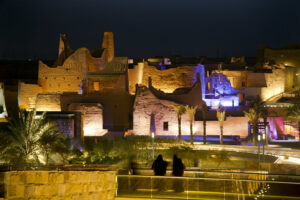
Just outside Riyadh lies Diriyah, a city steeped in history and deeply tied to the roots of modern Saudi Arabia.
As the birthplace of the first Saudi state and the ancestral home of the Al Saud royal family, Diriyah is more than just a historic site—it’s a powerful symbol of the nation’s beginnings, resilience, and enduring legacy.
At the heart of Diriyah is the At-Turaif District, a UNESCO World Heritage Site known for its beautifully preserved mud-brick buildings, winding alleyways, and old defensive walls.
Once a stronghold protecting the city from outside threats, At-Turaif now invites visitors to step back in time and explore what was once the political and cultural heart of the Arabian Peninsula during the 18th and 19th centuries.
One of Diriyah’s most iconic landmarks is Salwa Palace, the former royal residence of the Saudi family.
Now carefully restored and transformed into a museum, it offers a fascinating journey through the early history of the Saudi state, complete with exhibits, artifacts, and artworks that bring the past to life.
Diriyah also houses several historic mosques, such as the Imam Mohammed bin Saud Mosque and the Saad bin Saud Mosque.
These sacred spaces not only highlight traditional Arabian architecture—with their elegant domes, slender minarets, and beautifully designed prayer halls—but also reflect the deep spiritual roots of the local community.
Today, Diriyah stands as a living monument to Saudi Arabia’s cultural and historical identity.
Whether you’re exploring its ancient streets, visiting its storied landmarks, or simply soaking in the atmosphere, Diriyah offers a unique and unforgettable glimpse into the soul of the kingdom.
In addition to its historical sites, Diriyah in Saudi Arabia offers tourists opportunities for outdoor recreation, including hiking, picnicking, and horseback riding, amidst the picturesque desert landscape.
4. Al-Balad in Saudi Arabia:
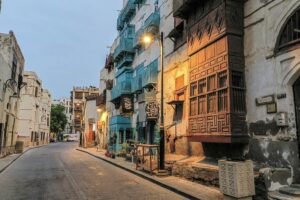
Tucked in the heart of Jeddah, Al-Balad—often called “Historic Jeddah” or the “Old Town”—is a vibrant district where the past and present beautifully collide.
It’s a place where tradition, culture, and commerce come together, offering visitors a truly immersive experience.
What sets Al-Balad apart are its unique coral stone buildings, known for their beautifully carved wooden balconies, colorful shutters, and intricately designed doors.
These structures not only reflect Jeddah’s deep maritime heritage but also highlight the rich blend of cultures that have shaped the city over centuries.
One of the most captivating parts of Al-Balad is its lively souqs.
These traditional markets are a sensory delight; in particular, they’re filled with the scent of spices, the vibrant colors of fabrics, and the sounds of friendly bargaining.
You’ll find everything from perfumes and textiles to antiques, handcrafted goods, and delicious local treats.
Al-Balad is also home to some of Jeddah’s oldest and most cherished mosques, including Al-Masjid Al-Mahalli and Al-Masjid Al-Kabir.
These sacred spaces, with their graceful domes and slender minarets, are not only architectural gems but also important centers of community life and religious tradition.
Beyond the historic sites, Al-Balad offers plenty of spots to relax and soak in the atmosphere. Quaint cafés, local art galleries, and cozy courtyards provide perfect places to pause and take it all in.
A stroll along the Al-Balad Corniche offers scenic views of the Red Sea and the city skyline, while nearby Al-Balad Park provides a peaceful green escape from the bustling streets.
With its rich heritage, buzzing street life, and warm community spirit, Al-Balad is more than just a historical district—it’s the soul of Jeddah.
5. At-Turaif District in Ad-Diriyah in Saudi Arabia:
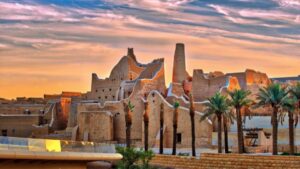
At-Turaif District, located in Ad-Diriyah on the outskirts of Riyadh, Saudi Arabia, is one of the UNESCO World Heritage and Historical Sites and a symbol of the kingdom’s rich history and cultural heritage.
Indeed, as the birthplace of the first Saudi state and the ancestral home of the ruling Al Saud family, At-Turaif District holds immense significance in the country’s history and identity.
The district is characterized by its well-preserved mud-brick buildings, defensive walls, and palaces, which date back to the 18th century.
Furthermore, these architectural King Abdulaziz Al Saud recaptured Riyadh in 1902, marking the beginning of the unification of the Arabian Peninsula under the Al Saud family, with Al-Masmak Fortress playing a pivotal role.
Marvels reflect the region’s traditional Arabian craftsmanship and provide insight into the lifestyle of the ruling elite during the early years of the Saudi state.
The Salwa Palace, an iconic At-Turaif landmark and former royal residence, has been meticulously restored and transformed into a museum.
Here, visitors can explore exhibits detailing the history of the Saudi state, as well as artifacts and artworks that offer insight into the region’s cultural heritage.
At-Turaif District hosts several historic sites, including Salwa Palace, Al-Zaher Palace, Imam Mohammed bin Saud Mosque, and Saad bin Saud Palace.
Visitors can explore architectural treasures on foot, wandering narrow alleyways to discover hidden courtyards, gardens, and fountains.
At-Turaif District also offers opportunities for outdoor recreation, with its scenic parks, gardens, and waterfront promenades.
Visitors can enjoy leisurely strolls, picnics, and boat rides, taking in views of the historic buildings and surrounding desert landscape.
At-Turaif District, rich in history and cultural significance, is a must-visit for tourists seeking the wonders of Saudi Arabia’s historic charm.
6. Al-Masmak Fortress in Saudi Arabia:
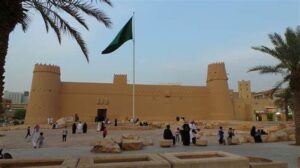
In other words, the Al Masmak Fort located in the heart of Riyadh, Saudi Arabia is one of the historical places for tourists which has cultural importance in the kingdom.
Built in the 19th century, the fortress played a pivotal role in the founding of the modern Saudi state and remains an enduring symbol of the kingdom’s heritage and resilience.
The fortress is constructed from mud-brick and clay, with thick walls and towering turrets that once served as defensive fortifications against invaders.
Moreover, its imposing architecture reflects the traditional Arabian style of fortress construction, featuring intricately carved wooden doors, ornate balconies, and decorative motifs adorning the exterior.
King Abdulaziz Al Saud recaptured Riyadh in 1902, marking the beginning of the unification of the Arabian Peninsula under the Al Saud family, with Al-Masmak Fortress playing a pivotal role.
The fortress’s central courtyard, surrounded by high walls and watchtowers, is where King Abdulaziz famously seized control of the city with a daring raid known as the “Raid on Al-Masmak.”
Afterward, the citadel’s central courtyard, surrounded by high walls and watchtowers, is where King Abdulaziz took control of the city in a daring attack famously known as the “raid of al-Masmak”.
Today, Al-Masmak Fortress is a meticulously restored museum showcasing artifacts, exhibits, and interactive displays on Riyadh’s and Saudi Arabia’s history and culture.
Additionally, visitors can explore the fortress’s interior, which includes reconstructed living quarters, armories, and a mosque, and learn about its role in shaping the destiny of the Saudi state.
Al-Masmak Fortress is a must-visit destination for tourists seeking to immerse themselves in the rich history and heritage of Saudi Arabia.
The fortress, with its exhibits, architecture, and historic significance, offers a unique opportunity to explore the kingdom’s past and its founders’ legacy.
7. Qasr Al-Hukm in Saudi Arabia:
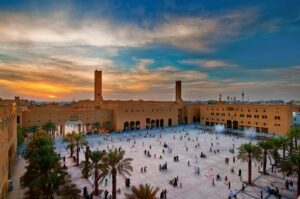
Qasr Al-Hikam, also known as the Palace of Justice, is one of the historical sites in the heart of Riyadh, Saudi Arabia, and attracts tourists.
Built in the traditional Arabian style, the palace houses the Saudi Supreme Court and holds significant cultural importance.
On the other hand, the distinctive blue-tiled dome of Qasr Al-Hukm is one of Riyadh’s most recognizable landmarks, standing as a symbol of justice and governance in Saudi Arabia.
The palace’s exterior is adorned with intricate geometric patterns, calligraphy, and ornate detailing, reflecting the kingdom’s rich cultural heritage and craftsmanship.
While Qasr Al-Hukm primarily functions as a governmental institution, it also welcomes visitors who are interested in exploring its historical significance and architectural beauty.
Tourists can admire the palace’s stunning exterior from the outside, taking in its majestic dome, arched windows, and decorative façade.
In addition to its architectural splendor, Qasr Al-Hukm offers visitors a glimpse into the kingdom’s legal system and judicial processes.
Inside the palace, visitors can explore exhibits and displays related to the Saudi legal system, as well as historical artifacts and documents that shed light on the palace’s role in the governance of the kingdom.
Surrounded by manicured gardens and fountains, Qasr Al-Hukm provides a tranquil retreat in the heart of Riyadh, where visitors can relax and soak in the atmosphere of this historic landmark.
The palace’s central location also makes it easily accessible to tourists exploring the city’s cultural and historical attractions.
With its stunning architecture, cultural significance, and historical legacy, Qasr Al-Hukm is a must-visit destination for tourists seeking to immerse themselves in the rich history and heritage of Saudi Arabia.
Whether admiring its exterior beauty or exploring its interior exhibits, visitors are sure to be captivated by the majesty of this iconic palace.
8. Al-Khazneh in Saudi Arabia:
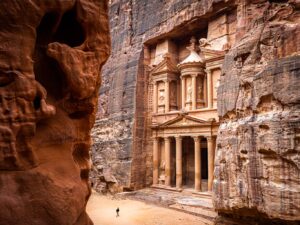
Al-Khazneh, while often associated with the famous Petra in Jordan, is not found in Saudi Arabia.
However, Saudi Arabia is home to other magnificent archaeological and historical sites that offer tourists a unique insight into its rich heritage.
One such site is the Nabatean city of Hegra (also known as Mada’in Saleh), which features its own set of remarkable rock-cut monuments and tombs, similar to those of Petra.
Located in the Al-Ula region, Hegra is Saudi Arabia’s first UNESCO World Heritage Site and showcases the grandeur of the Nabatean civilization.
The site features over 100 well-preserved tombs with elaborate facades carved into the sandstone cliffs.
Among the most notable is the Qasr al-Farid, or “The Lonely Castle,” an isolated tomb renowned for its impressive size and intricate carvings.
In short, visitors to Hegra can explore these ancient structures and marvel at the skill and artistry of the Nabateans, who flourished in this region from the 1st century BCE to the 1st century CE.
The site also includes ruins of residential areas, market places, and religious sanctuaries, offering a comprehensive view of life in this ancient desert city.
Additionally, Hegra’s location in the dramatic desert landscape of Al-Ula adds to its allure, with towering sandstone formations and expansive vistas providing a breathtaking backdrop for exploration.
The nearby Al-Ula Old Town further enriches the experience with its traditional mud-brick buildings and vibrant souqs.
For tourists, a visit to Hegra is a journey into the heart of ancient Arabia, where history, culture, and natural beauty converge.
Whether wandering through the majestic tombs, exploring the ruins, or simply soaking in the serene desert environment, visitors will find Hegra an unforgettable destination in Saudi Arabia.
9. Al-Qarah Mountain in Saudi Arabia:

Al-Qarah Mountain, located near the city of Al-Hofuf in the Al-Ahsa region of Saudi Arabia, is a captivating natural wonder and a significant cultural site.
Known for its unique geological formations and historical significance, Al-Qarah Mountain offers tourists an enriching and memorable experience.
Apart from this, the mountain is also famous for its magnificent rock formations and network of caves.
These formations, created by centuries of wind and water erosion, present an otherworldly landscape of towering cliffs, narrow canyons, and cavernous spaces.
The caves of Al-Qarah, naturally cool even during the intense heat of the desert summer, provide a refreshing respite for visitors and a fascinating subject for exploration.
One of the most notable caves is Jebel Qarah, which features well-lit paths and stairs to guide tourists through its impressive interiors.
Visitors can marvel at the intricate patterns and textures of the cave walls, shaped by natural forces over millennia. The caves have also served historically as shelter and meeting places for local inhabitants, adding to their cultural significance.
Beyond the natural beauty, Al-Qarah Mountain is surrounded by the lush oasis of Al-Ahsa, the largest oasis in the world and a UNESCO World Heritage Site.
In addition, the region is famous for its extensive date palm groves, ancient canals, and historic sites, which offer a striking contrast to the rugged mountain landscape
Tourists can enjoy one of the historical sites in Saudi Arabia that explores the geological, and cultural aspects of the mountain and its surroundings.
Additionally, the nearby Al-Ahsa heritage sites, such as the Jawatha Mosque and the Al-Ahsa National Museum, complement the visit to Al-Qarah Mountain by providing deeper insights into the region’s rich history and traditions.
10. Old Town of Al-Dir’iyyah in Saudi Arabia:

The Old Town of Al-Dir’iyyah, near Riyadh, offers tourists a captivating glimpse into Saudi Arabia’s rich past.
As the original home of the Saudi royal family and the first Saudi state, Al-Dir’iyyah is culturally significant.
One of the most prominent attractions in Al-Dir’iyyah is the At-Turaif District, a UNESCO World Heritage Site.
This area is famous for its well-preserved mud-brick buildings, traditional Arabian architecture, and defensive structures.
Visitors can explore the narrow alleyways and grand palaces that reflect the architectural style of the Najdi region.
The Salwa Palace, the former residence of the Al Saud family, stands out as a key landmark where visitors can delve into the history of the Saudi state.
Additionally,
Tourists can enjoy walking tours of Al-Dir’iyyah, where guides provide detailed narratives about the site’s historical events and cultural significance.
Al-Dir’iyyah’s historical landmarks, cultural exhibits, and natural beauty make it a must-visit for anyone interested in Saudi Arabia’s history and culture.
Whether you’re a history enthusiast, a cultural explorer, or simply a curious traveler, the Old Town of Al-Dir’iyyah offers a unique and enriching experience.
Historical sites in Saudi Arabia offer diverse experiences, from ancient ruins and architectural marvels to natural wonders and cultural landmarks.
Each site has its own unique story to tell and provides valuable insight into the country’s rich and diverse heritage.







